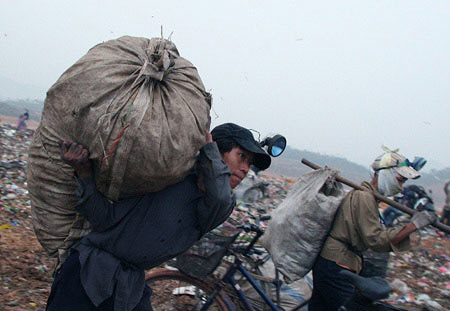$ 140 million to build the largest waste treatment plant in Vietnam
Waste treatment plant with a capacity of 2,000 tons / day - night with an investment of 140 million USD, was started on September 18, at Nam Son Waste Treatment Complex, Hanoi.
This is a pioneering and large-scale project in the field of environmental treatment of Hanoi and the whole country. The factory was built on an area of about 155 hectares. The plant uses an integrated technology system, including: Classification system, pressing - packing system, composting system and waste water treatment system, recyclable materials used for leveling, embankment.

A scavenger works at Nam Son landfill, Hanoi, early in the morning.
(Photo: Minh Tri).
It is expected that by the end of 2011, the factory will go into operation and after 25 years from the time of operation, the company will transfer the factory to the city for management.
Speaking at the ceremony, Chairman of Hanoi City People's Committee Nguyen The Thao hopes that when the project comes into operation, it will positively contribute to minimizing the regional environmental pollution and at the same time extend the operation time of the Zone. Nam Son waste treatment complex, Soc Son, Hanoi.
Currently, the total amount of solid waste in Hanoi city is estimated at 5,000 tons / day-night, of which about 3,500 tons are urban domestic waste and the rest is rural domestic waste. However, up to 85-90% of unsanitary landfills are at risk of causing high environmental pollution. As expected, if we continue to receive the waste as much as today, by 2015, Hanoi will no longer have a landfill.
According to the Ministry of Construction data in 2009, the total amount of urban solid waste generated nationwide is estimated at 21,500 tons / day. The forecast of the Ministry of Construction and Ministry of Natural Resources and Environment said that by 2015, the volume of domestic solid waste generated from urban areas is estimated at 37,000 tons / day and 59 thousand tons / day by 2020, which is 2 - 3 times now.
- China built the world's largest garbage power plant
- Technology of solid waste treatment into PO oil and RO
- Waste treatment solution for hospitals in Vietnam
- 'Engineers are not equal to processing medical waste treatment furnaces
- He built a new bioelectric plant
- He plans to build the world's largest tidal power plant
- Building the largest solid waste treatment area in the country
- Discover the most dangerous place in the UK
- Use VIBIO technology to turn garbage into compost
- Ancient plant compounds discovered in salt walls of waste treatment sites
- Vietnam is the top 5 countries that discharge most plastic waste into the sea
- Waste water treatment using anaerobic digestion technology
 Is the magnetic North Pole shift dangerous to humanity?
Is the magnetic North Pole shift dangerous to humanity? Washington legalizes the recycling of human bodies into fertilizer
Washington legalizes the recycling of human bodies into fertilizer Lightning stone - the mysterious guest
Lightning stone - the mysterious guest Stunned by the mysterious sunset, strange appearance
Stunned by the mysterious sunset, strange appearance